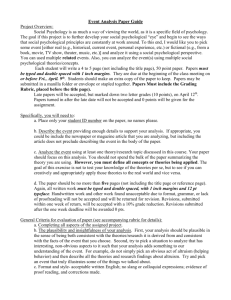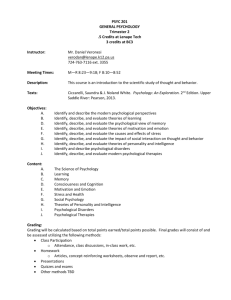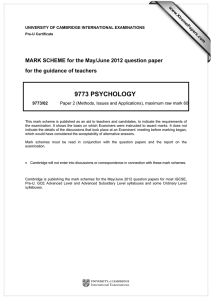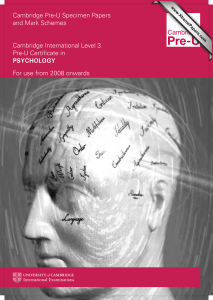9773 PSYCHOLOGY MARK SCHEME for the May/June 2010 question paper
advertisement
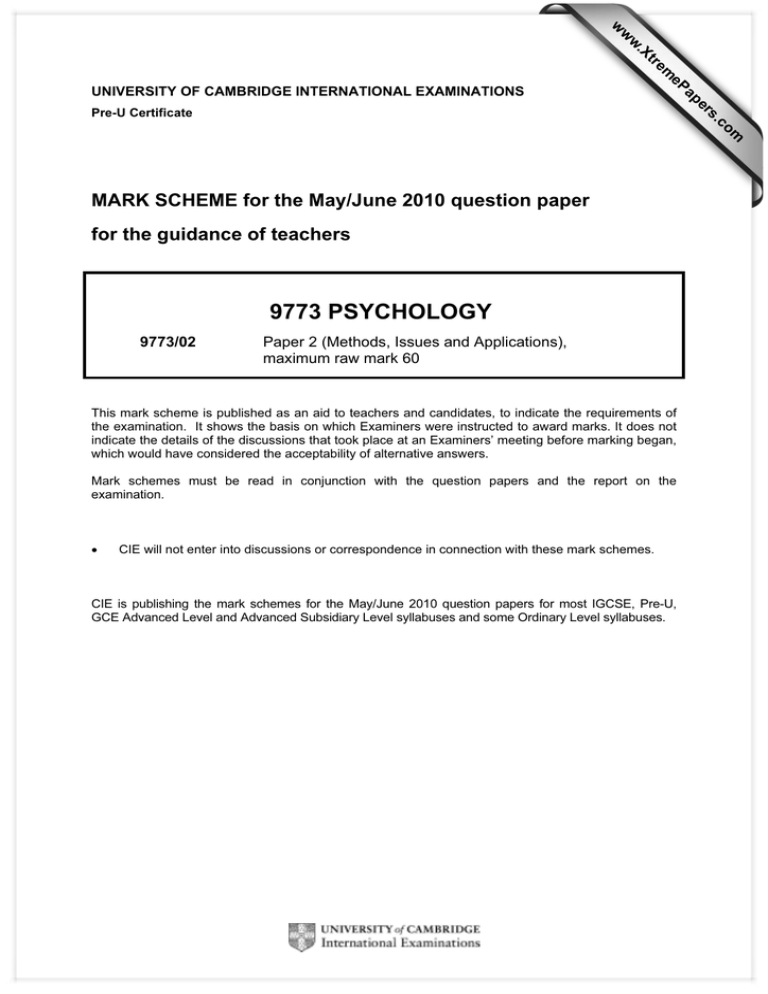
w w ap eP m e tr .X w UNIVERSITY OF CAMBRIDGE INTERNATIONAL EXAMINATIONS s er om .c Pre-U Certificate MARK SCHEME for the May/June 2010 question paper for the guidance of teachers 9773 PSYCHOLOGY 9773/02 Paper 2 (Methods, Issues and Applications), maximum raw mark 60 This mark scheme is published as an aid to teachers and candidates, to indicate the requirements of the examination. It shows the basis on which Examiners were instructed to award marks. It does not indicate the details of the discussions that took place at an Examiners’ meeting before marking began, which would have considered the acceptability of alternative answers. Mark schemes must be read in conjunction with the question papers and the report on the examination. • CIE will not enter into discussions or correspondence in connection with these mark schemes. CIE is publishing the mark schemes for the May/June 2010 question papers for most IGCSE, Pre-U, GCE Advanced Level and Advanced Subsidiary Level syllabuses and some Ordinary Level syllabuses. Page 2 1 Mark Scheme: Teachers’ version Pre-U – May/June 2010 Syllabus 9773 Paper 02 Methodology (a) Describe two conclusions that can be drawn from the table above. [4] Possible conclusions include: • • In the drunk condition there was a slight (non significant) ‘same race’ effect – whites were more likely to help white victims and blacks to help black victims. This interesting tendency toward same-race helping only in the case of the drunk victim may reflect more empathy, sympathy and trust toward victims of one's own racial group. The cane victim was spontaneously helped in most of the trials. Diffusion of responsibility is not found on cane trials because costs for helping in general are low and costs for not helping are high (more self-blame because of possible severity of problem). NOTE: any appropriate conclusion can receive credit; the hints are for guidance only. 1 mark for basic conclusion e.g. ‘in the drunk condition there was a slight race effect’; 2 marks for elaboration, such as reference to the other conditions or the addition of data to support the comment. Twice. (b) Describe two possible confounding variables in this study and suggest how these variables could have been controlled. [8] Possible confounding variables include: • • • • Passengers on the train might have seen more than one trial and this might have led to demand characteristics. Participants might have not displayed diffusion of responsibility because of the location in which the experiment was conducted i.e. train and not because they were willing to help. There was only one black victim participating in the study and therefore generalisation is difficult as the results might have been due to his personality characteristics and not due to his race. The study was conducted between the hours of 11am and 3pm and as a result a large number of the population such as those in full time employment were not represented in the study. 1 mark for identification of a confounding variable and a further mark for elaboration or explanation. Twice. The variables can be controlled by: • • • • Conducting a lab experiment in which participants have been carefully selected beforehand to avoid participation in more than one trial. Conducting the experiment in a different environment, e.g. high street. Recruit a larger number of stooges to act as victims so generalization can be easier. Replicate the study at different times to make sure that the population as a whole is represented. NOTE: any appropriate answer can receive credit; the hints are for guidance only. 1 mark for a suggestion as to how the variables can be controlled and 1 mark for elaboration. Twice. © UCLES 2010 Page 3 Mark Scheme: Teachers’ version Pre-U – May/June 2010 Syllabus 9773 Paper 02 (c) Debate the use of controls when investigating bystander behaviour. [8] Strengths and weaknesses need to be closely related to the area of bystander behaviour. Strengths and weaknesses need to be fully explained and not merely identified. Strengths can include: • Allow us to measure cause and effect as extraneous variables are controlled and so we can measure the effect of the IV on the DV. • Enable the investigation to be replicated as control of variables allows standardised procedures to be in place. • Increase the overall validity of the investigation, as confounding variables can be minimised and so we can be more certain that we are measuring the effect of the IV on the DV and not the effect of extraneous variables on the DV. Weaknesses include: • Lower ecological validity as real life is not controlled. • Increase the likelihood of demand characteristics as participants are often tested in a lab environment and they are aware that they participate in an investigation. NOTE: any appropriate evaluation point can receive credit; the hints are for guidance only. © UCLES 2010 Page 4 Mark Scheme: Teachers’ version Pre-U – May/June 2010 Syllabus 9773 Paper 02 marks Debate is comprehensive. Quality and depth of argument (or comment) is impressive. Selection and range of arguments is balanced and competently organised into issues/debates, methods or approaches. Effective use of appropriate supporting examples which are explicitly related to the question. Analysis (valid conclusions that effectively summarise issues and arguments) is evident throughout. Evaluation is detailed and quality of written communication is very good. Understanding and usage of psychological concepts, issues and approaches is extensive. 7–8 Debate is good. Quality and depth of argument (or comment) is clear and well-developed. Selection and range of arguments is balanced and logically organised into issues/debates, methods or approaches. Good use of appropriate supporting examples which are related to the question. Analysis (key points and valid generalisations) is often evident. Evaluation is quite detailed and quality of written communication is very good. Understanding and usage of psychological concepts, issues and approaches is competent. 5–6 Debate is competent. Quality and depth of argument (or comment) is reasonable. Selection and range of arguments may be imbalanced, with some organisation into issues/debates, methods or approaches evident. Reasonable use of appropriate supporting examples which are related to the question. Analysis (key points and valid generalisations) is sometimes evident. Evaluation has some detail and quality of written communication is good. Understanding and usage of psychological concepts, issues and approaches is good. 3–4 Debate is reasonable. Quality and depth of argument (or comment) is basic. Selection and range of arguments is often imbalanced, with attempted organisation into issues/debates, methods or approaches evident. Some use of appropriate supporting examples which are often peripherally related to the question. Analysis (key points and valid generalisations) is discernible. Evaluation has little detail and quality of written communication is adequate. Understanding and usage of psychological concepts, issues and approaches is sufficient. 1–2 No or irrelevant answer. 0 © UCLES 2010 Page 5 2 Mark Scheme: Teachers’ version Pre-U – May/June 2010 Syllabus 9773 Paper 02 Issues, Approaches and Perspectives (a) Using examples from research, outline two assumptions of the social approach in psychology. [6] Candidates can use any appropriate research from any key theory and study or from any key application and ‘the explore more’ section. Main assumptions of the social approach in psychology include: • Human behaviour is affected by the presence of others. • Behaviour is situational and not dispositional. Examples can include: • • Haney, Banks & Zimbardo simulated a prison to show how people behave in restrictive social situations. They provided evidence against the dispositional hypothesis as the behaviour of the participants was affected by the role they had been assigned. Milgram demonstrated how people were prepared to follow the orders of an authority figure, demonstrating how the presence of such an authority figure can often lead us to behave in inhumane ways. NOTE: any appropriate answer can receive credit; the hints are for guidance only. marks Description of two assumptions from the social approach in psychology is accurate and has elaboration. The candidate clearly understands what they have written. Effective use of appropriate supporting examples which are explicitly related to the question. 5–6 Description of two assumptions of the social approach in psychology is accurate, has some elaboration, and some understanding. Good use of appropriate supporting examples which are related to the question. OR Description of one assumption from the social approach in psychology which is accurate and has elaboration. The candidate clearly understands what they have written. Effective use of appropriate supporting examples which are explicitly related to the question (can achieve maximum of 3 marks). 3–4 Description of two assumptions of the social approach in psychology is basic, with little or no elaboration and little understanding. Reasonable use of appropriate supporting examples which are related to the question. OR Description of one assumption of the social approach in psychology is accurate, has some elaboration, and some understanding. Good use of appropriate supporting examples which are related to the question. 1–2 No or irrelevant answer. 0 © UCLES 2010 Page 6 Mark Scheme: Teachers’ version Pre-U – May/June 2010 Syllabus 9773 Paper 02 (b) Contrast the social approach in psychology with the physiological approach when explaining shyness. [6] The question requires not only knowledge of the social and physiological approaches in psychology but also the ability to contrast. Further than this, it requires candidates to apply their knowledge of the different approaches to explain shyness. • • • The social approach in psychology will consider shyness to occur as a result of the interaction of the individual with its environment. Unfamiliar situations might trigger uncomfortable feelings. Shyness can be viewed by the physiological approach to have a genetic basis that implies that the individual is born shy. Can shyness occur without a social situation? NOTE: any appropriate answer can receive credit; the hints are for guidance only. marks Contrasts are appropriate. Description of contrasts is accurate and detailed. Relationship of shyness to debate is explicit. Understanding is full. 5–6 Contrasts are attempted. Description of contrasts is generally accurate with good detail. Relationship of shyness to debate is evident. Understanding is good. 3–4 Contrasts are attempted. Description of alternatives is evident with some detail. Some understanding is evident. 1–2 No or irrelevant answer. 0 (c) Using examples from research, explain why ethics might be an issue when adopting the social approach in psychology. [8] Any relevant research will be credited. • • • If participants were aware that they were being observed they would change their behaviour to fit the experimenter’s expectations. As a result deception is usually used to increase ecological validity and reduce demand characteristics. Informed consent can be an issue when adopting the social approach in psychology. Social psychologists often conduct field experiments in which participants are unaware that are being studied and thus informed consent cannot be gained. Participants can often suffer psychological harm due to the tasks required during social psychology experiments. © UCLES 2010 Page 7 Mark Scheme: Teachers’ version Pre-U – May/June 2010 Syllabus 9773 Paper 02 Examples include: • • Most of the ethical guidelines were broken in Milgram’s study. Participants were deceived in a number of ways. For example they thought they were participating in an experiment that investigated learning and memory, when in reality the experiment investigated obedience to authority. Participants were not given the right to withdraw as the prods used by the experimenter suggested that they had to continue with the experiment. Participants displayed clear signs of distress such as sweating, shaking, stuttering, biting their lips, groaning, digging fingernails into own flesh. Piliavin did not ask consent (the participants did not even know they were in an experiment), did not debrief and employed deception. He may have upset some of the train passengers even though, in all conditions, the victim was eventually helped off the train by the model. NOTE: any appropriate answer can receive credit; the hints are for guidance only. marks Explanation is accurate and use of psychological terminology is comprehensive. Description of knowledge (theories/studies) is accurate, coherent and detailed. Understanding (such as elaboration, use of example, quality of description) is very good. Apposite examples are used throughout. The answer is competently structured and organised (global structure introduced at start and followed throughout). Quality of written communication is very good. 7–8 Explanation is mainly accurate and use of psychological terminology is competent. Description of knowledge (theories/studies) is mainly accurate, coherent and reasonably detailed. Understanding (such as elaboration, use of example, quality of description) is good. Appropriate examples are used throughout. The answer has structure and organisation. Quality of written communication is good. 5–6 Explanation is basic and use of psychological terminology is adequate. Description of knowledge (theories/studies) is often accurate and generally coherent, but lacks detail. Understanding (such as elaboration, use of example, quality of description) is reasonable. Peripherally relevant examples are used throughout. The answer has some structure or organisation. Quality of written communication is good. 3–4 Explanation and use of psychological terminology is evident. Description of knowledge (theories/studies) is sometimes accurate and has coherence, but is brief. Understanding (such as elaboration, use of example, quality of description) is discernible. Examples are used occasionally. The answer has discernible structure or organisation. Quality of written communication is adequate. 1–2 No or irrelevant answer. 0 © UCLES 2010 Page 8 3 Mark Scheme: Teachers’ version Pre-U – May/June 2010 Syllabus 9773 Paper 02 Applications (a) Describe psychological evidence and/or theories that could be relevant to the issues raised in the source. [10] Candidates are required to identify and describe in some detail evidence and/or theories relevant to the issues raised in the source. The Philips et al. (1993) study and the Rhodes, Proffitt, Grady and Sumich (1998) study are obvious examples, but any relevant study will be credited. Candidates can use any appropriate evidence from any other key theory and study or from any key application and ‘the explore more’ section. marks Description of knowledge (theories/studies) is accurate, coherent and detailed. Use of terms is accurate and use of psychological terminology is comprehensive. The theories/studies described are wide-ranging. Understanding (such as elaboration, use of example, quality of description) is very good. The answer is competently structured and organised (global structure introduced at start and followed throughout). Quality of written communication is very good. 8–10 Description of knowledge (theories/studies) is mainly accurate, coherent and reasonably detailed. Use of terms is mainly accurate and use of psychological terminology is competent. The theories/studies described cover a reasonable range. Understanding (such as elaboration, use of example, quality of description) is good. The answer has some structure and organisation. Quality of written communication is good. 5–7 Description of knowledge (theories/studies) is often accurate and generally coherent, but lacks detail. Use of terms is basic and use of psychological terminology is adequate. The theories/studies described cover a reasonable range. Understanding (such as elaboration, use of example, quality of description) is reasonable. The answer has some structure and organisation. Quality of written communication is good. 3–4 Description of knowledge (theories/studies) is sometimes accurate and has some coherence, but is brief. Use of terms and use of psychological terminology is discernible. The theories/studies described cover a narrow range. Understanding (such as elaboration, use of example, quality of description) is sufficient. The answer has little structure and/or organisation. Quality of written communication is adequate. 1–2 No or irrelevant answer. 0 © UCLES 2010 Page 9 Mark Scheme: Teachers’ version Pre-U – May/June 2010 Syllabus 9773 Paper 02 (b) Explain the issues raised in the source using the evidence and/or theories you described in part (a). [10] Candidates are required to apply their knowledge of the studies and/or theories described in part (a) to explain the issues raised in the source. At least two issues need to be explained with the evidence explicitly applied to the source. Some evaluation of the validity of the suggested evidence and/or theories in explaining the issues raised is necessary, although this does not need to be extensive. Only one issue, but detailed = max 7. Only one issue, but general = max 4. grade Quality of explanation and depth of argument is impressive. Application of knowledge (theories/studies) described in part (a) is accurate, coherent and detailed. Use of terms is accurate and use of psychological terminology is comprehensive. Understanding (such as elaboration, use of example, quality of description) is very good. The answer is competently structured and organised (global structure introduced at start and followed throughout). Quality of written communication is very good. Relationship to the events raised in the source is explicit. 8–10 Quality of explanation and depth of argument is very good. Application of knowledge (theories/studies) is mainly accurate, coherent and reasonably detailed. Use of terms is mainly accurate and use of psychological terminology is competent. Understanding (such as elaboration, use of example, quality of description) is good. The answer has some structure and organisation. Quality of written communication is good. Relationship to the events raised in the source is evident. 5–7 Quality of explanation and depth of argument is competent. Application of knowledge (theories/studies) is often accurate and generally coherent, but lacks detail. Use of terms is basic and use of psychological terminology is adequate. Understanding (such as elaboration, use of example, quality of description) is reasonable. The answer has some structure and organisation. Quality of written communication is good. Relationship to the events raised in the source is evident in parts. 3–4 Quality of explanation and depth of argument is basic. Application of knowledge (theories/studies) is sometimes accurate and has some coherence, but is brief. Use of terms and use of psychological terminology is discernible. Understanding (such as elaboration, use of example, quality of description) is sufficient. The answer has little structure and/or organisation. Quality of written communication is adequate. Relationship to the events raised in the source is implicit. 1–2 No or irrelevant answer. 0 © UCLES 2010

